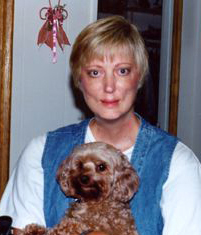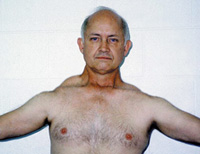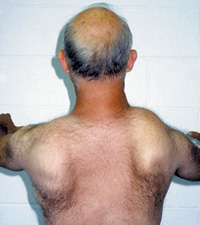
Facioscapulohumeral Muscular Dystrophy (FSH, FSHD)
Signs and Symptoms
The age of onset, progression, and severity of facioscalpulohumeral muscular dystrophy (FSHD) vary a great deal.
Usually, symptoms develop during the teen years, with most people noticing some problems by age 20, although weakness in some muscles can begin as early as infancy and as late as the 50s. In some people, the disease can be so mild that no symptoms are noticed. In these cases, the disease may be diagnosed only after another, more affected member of the family comes to medical attention.
People with FSHD often do not go to the doctor until their shoulder or leg muscles become involved and they experience difficulty reaching over their heads or going up and down stairs. When questioned closely, many people can remember having symptoms in childhood, such as shoulder blades that stuck out or trouble throwing a ball. Very often, people say they have never been able to whistle or blow up a balloon, or that they have had trouble drinking through a straw, but they may not have associated these problems with muscular dystrophy.
FSHD does not affect sensation, nor does it affect ability to control the bladder and bowels, or sexual function.
In most people with FSHD, the disease progresses very slowly. It can take as long as 30 years for the disease to become seriously disabling, and that does not happen to everyone. Estimates are that about 20% of people with FSHD eventually use a wheelchair at least some of the time. For more on corrective measures for some of these symptoms, see Medical Management.
Abdominal muscle weakness
In many people with FSHD, weakness develops in the muscles of the abdomen. These can weaken early in the disorder. As abdominal weakness progresses, a person develops a lordosis, an exaggerated curve in the lumbar (lower) region of the spine.
Abnormalities of the retina
Some abnormalities in the blood vessels of the retina, the “screen” on the back of the eye onto which visual images are projected, are often detected in 50% to 75% of people with FSHD.1,2 Fortunately, very few people have any vison problems resulting from this, but patients should be monitored by an eye doctor. Visual acuity loss affects approximately 1% of patients with FSHD. For reasons that are not clear, the problem is generally more common in infantile-onset FSHD.
Due to facial weakness, the eyes may remain partially open during sleep in patients with FSHD,3 which can cause exposure keratitis (inflammation of the cornea). To prevent eyeball damage, ophthalmic ointments and eye patches can be used at night. However, tape should not be placed directly on the eyelid because the patch could slip and injure the cornea.
Cardiac and respiratory function
Although cardiac involvement can sometimes be a factor in FSHD, it is rarely severe and is often discovered only with specialized testing. Some experts have recently recommended monitoring of cardiac function in those with FSHD.
The muscles used for breathing commonly are not affected in FSHD, as they are in other forms of muscular dystrophy. However, testing of pulmonary function at intervals may be recommended for some patients. Respiratory insufficiency rarely occurs; however, around 1% of patients with FSHD may require nocturnal ventilatory support.4
Dysphagia (difficulty in swallowing) is rare in patients with FSHD but can develop due to weakness of the jaw and lingual muscles.5
Facial weakness
Facial weakness can make it hard to use a straw or even smile.
Facial weakness is often the first sign of FSHD. It may not be noticed right away by people with FSHD and usually is brought to their attention by somebody else.
The muscles most affected are those that surround the eyes and mouth. It is hard to smile, pucker the lips, or get much strength in the mouth, which is why people with the disease have trouble with balloons, straws, and whistling.
Hip weakness
In some people, weakness of the hip muscles that surround the pelvis (the pelvic girdle) also occurs. This does not happen to everyone. Weakness of the hips seems to start most often in middle adulthood, if it happens at all.
Hip weakness causes trouble with rising from a chair or climbing stairs and can lead to the need for a wheelchair, especially for long distances. Upper leg muscles are sometimes also affected. Pelvic girdle weakness may result in a waddling gait and contribute to the lordosis so often seen in FSHD.
In children with FSHD, hip weakness may be the first thing parents notice because it causes trouble with walking and running.
Joint and spinal abnormalities
The spinal column is made up of many joints between the vertebrae. The spine is designed to be flexible, somewhat like a Slinky toy, so when the muscles surrounding the spine weaken, the column is pulled out of alignment.
The misalignment often takes the form of lordosis, where the spine curves in to an excessive degree and the stomach sticks out. But it also can take the form of scoliosis, in which the spine curves to the side, like an S. The scoliosis that sometimes occurs in FSHD usually is not severe.
Lower leg weakness
As FSHD progresses, the muscles on the front and sides of the lower legs muscles (peroneal muscles) often weaken. These are the muscles that allow us to raise the front of the foot when walking so we do not trip over our toes.
When these muscles weaken, the foot stays down after pushing off during walking, sometimes tripping the walker. This condition is called foot drop.
The doctor may say, “Walk on your heels, like a penguin” to test the strength of these foot-lifting muscles. When questioned, people will say, “I seem to catch my foot when I walk,” or, “I seem to fall over my own feet.” Trouble with stairs and with uneven surfaces is common.
Not everyone with FSHD develops this lower leg problem.
Mild hearing loss
Hearing loss sometimes occurs in FSHD, mainly in its infantile form. Often, it is minor and unnoticed until careful testing is done (for example, during routine school-based hearing assessments). In those with adult-onset FSHD, some experts have even questioned whether hearing loss is really more common than it is in adults in general. The reason for the hearing loss, when it occurs, is not clear.
When FSHD starts in childhood, loss of hearing in the higher pitch ranges can be more profound than in adult-onset FSHD.
Pain and inflammation
Inflammation of muscles — an attack by certain types of cells of the immune system — occurs in some muscular dystrophies and can be extensive in some people with FSHD.
For this reason, FSHD is sometimes misdiagnosed as another type of muscle disease, polymyositis, a nongenetic disorder in which the immune system attacks the muscles. An important difference is that polymyositis is treatable with prednisone, a corticosteroid drug that suppresses inflammation, but prednisone does not affect the course of FSHD.6 The many side effects of corticosteroids make them impractical to use just to relieve discomfort.
Pain in FSHD is likely multifactorial, including contributions from myalgias and from biomechanical stress related to muscle weakness and postural problems. The most common locations for pain include the shoulder, neck, lower back, and lower legs. Chronic pain affects 55% to 80% of patients with FSHD, with severe pain in up to 23%.6,7,8,9
Shoulder weakness
Because of weakness in the shoulders and back, muscles that normally do not show from the front are visible in FSHD.
Most people with FSHD notice weakness in the area of the shoulder blades — the scapulae — as the first sign that something is amiss.
The shoulder blades are normally fairly fixed in their position. They act as fulcrums that allow the arm muscles to get leverage for lifting things, including their own weight.
In FSHD, the muscles that hold the shoulder blades in place weaken, allowing these bones to move excessively. The shoulder blades stick out and rise up toward the neck as they move, which is called scapular winging, because the protruding bone resembles a wing.
Leverage is at least partially lost. Weakness often is not the same on both sides of the body.
This man also shows a typical nonsymmetrical pattern of weakness, with scapular winging and slight scoliosis.
 Early on, a person with FSHD notices things like being unable to throw a ball effectively. Later, it may be hard to lift the arms over the head to do one’s hair or reach a high shelf or hang something. These problems are due to weakening of the muscles around the shoulder and in the upper arm. For information about shoulder surgery for this problem, see Medical Management.
Early on, a person with FSHD notices things like being unable to throw a ball effectively. Later, it may be hard to lift the arms over the head to do one’s hair or reach a high shelf or hang something. These problems are due to weakening of the muscles around the shoulder and in the upper arm. For information about shoulder surgery for this problem, see Medical Management.
Unequal (nonsymmetrical) weakness
In most people with FSHD, weakness differs at least a little bit between the left and right sides of the body. In some people with FSHD, this difference between sides can be quite striking. The reason for this lack of symmetry, which is not seen in most types of muscular dystrophy, is not clear.
References
- Padberg, G. W. et al. On the significance of retinal vascular disease and hearing loss in facioscapulohumeral muscular dystrophy. Muscle Nerve (1995). doi:10.1002/mus.880181314
- Fitzsimons, R. B., Gurwin, E. B. & Bird, A. C. Retinal vascular abnormalities in facioscapulohumeral muscular dystrophy: A general association with genetic and therapeutic implications. Brain (1987). doi:10.1093/brain/110.3.631
- Tawil, R. Facioscapulohumeral muscular dystrophy. in Handbook of Clinical Neurology (2018). doi:10.1016/B978-0-444-64076-5.00035-1
- Wohlgemuth, M., Van Der Kooi, E. L., Van Kesteren, R. G., Van Der Maarel, S. M. & Padberg, G. W. Ventilatory support in facioscapulohumeral muscular dystrophy. Neurology (2004). doi:10.1212/01.WNL.0000133126.86377.E8
- Wohlgemuth, M. et al. Dysphagia in facioscapulohumeral muscular dystrophy. Neurology (2006). doi:10.1212/01.wnl.0000219760.76441.f8
- Van Der Kooi, E. L. et al. Effects of training and albuterol on pain and fatigue in facioscapulohumeral muscular dystrophy. J. Neurol. (2007). doi:10.1007/s00415-006-0432-4
- Jensen, M. P. et al. Chronic Pain in Persons With Myotonic Dystrophy and Facioscapulohumeral Dystrophy. Arch. Phys. Med. Rehabil. (2008). doi:10.1016/j.apmr.2007.08.153
- Padua, L. et al. Quality of life and pain in patients with facioscapulohumeral muscular dystrophy. Muscle and Nerve (2009). doi:10.1002/mus.21308
- Morís, G. et al. Chronic pain has a strong impact on quality of life in facioscapulohumeral muscular dystrophy. Muscle and Nerve (2018). doi:10.1002/mus.25991

